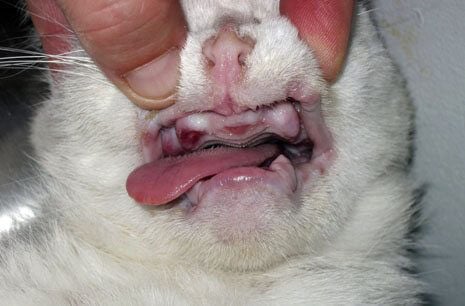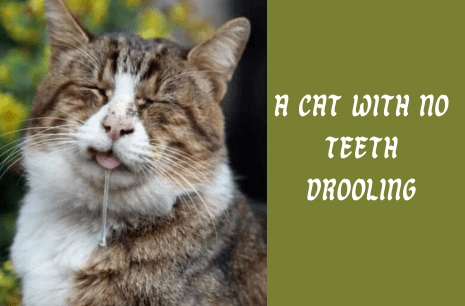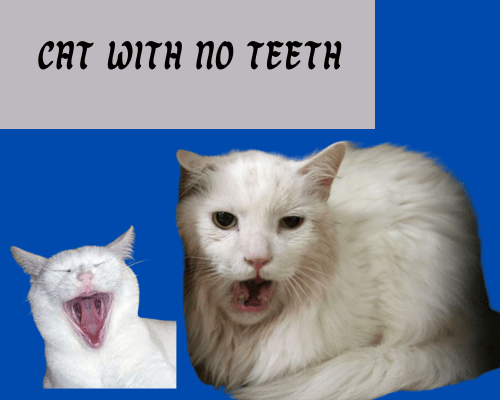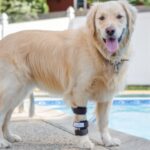Cats are amazing creatures that can live happy and healthy lives even without their teeth. However, some owners may have questions or concerns about how to best care for their feline friends who have lost or are losing their teeth due to various reasons.
In this article, we will answer some of the most common questions about a cat with no teeth and provide some tips and advice on how to make sure your toothless cat is comfortable and well-fed.
Contents
A cat with no teeth why Lose Their Teeth?
There are several possible causes of tooth loss in cats, but the most common one is dental disease. Dental disease is a term that covers a range of oral problems, such as gingivitis, periodontitis, tooth resorption, and stomatitis.
These conditions can affect up to 80% of cats by the age of three and can cause inflammation, infection, pain, and tooth decay. Without proper treatment, dental disease can lead to tooth extraction or tooth loss.
Another possible cause of tooth loss in cats is old age. As cats age, their teeth may become weaker and more prone to breaking or falling out. This is especially true for cats who have not received regular dental care throughout their lives. Older cats may also have other health issues that can affect their oral health, such as kidney disease, diabetes, or hyperthyroidism.
A less common cause of tooth loss in cats is trauma. This can happen when a cat suffers an injury to the mouth, such as from a fight, an accident, or a foreign object. Trauma can damage the teeth, the gums, or the jawbone, and may require surgical intervention or tooth removal.
How Does a Toothless Cat Eat?
One of the main concerns that owners have about their toothless cats is how they will eat. Fortunately, most cats can adapt very well to eating without teeth, as long as they are given the right food and the right environment.
Cats are carnivores, which means they have teeth that are designed for grabbing and tearing meat, rather than chewing or grinding. Therefore, cats do not rely on their teeth as much as humans do for eating. Instead, they use their tongue, which is covered with tiny barbs, to scoop up food and push it to the back of their mouth, where they swallow it whole or in large chunks.
However, this does not mean that cats can eat any kind of food without teeth. Some foods may be too hard, too dry, or too large for a toothless cat to handle. Therefore, it is recommended to feed your toothless cat canned food or softened kibble.
Canned food is generally easier for cats to eat, as it is moist, soft, and has a strong smell and taste. Softened kibble can be made by adding some water or broth to dry food and letting it soak for a few minutes. Some cats may prefer a chunkier texture, so you can also try mixing some kibble with canned food.
The shape and size of the food also matter. Some cats may have trouble picking up round or flat pieces of food with their tongue, so you may want to look for food that has a triangular or irregular shape. You can also try cutting or shredding the food into smaller pieces to make it easier for your cat to eat.
Another important factor is the environment. Some cats may feel stressed or insecure when eating without teeth, especially if they have to share their food with other cats or animals. This can affect their appetite and their digestion. Therefore, it is important to provide your toothless cat with a quiet, comfortable, and safe place to eat, where they can enjoy their food without being disturbed or threatened.
Cat with no teeth treatment
If a cat has no teeth or is losing their teeth due to dental disease or other causes, they may need some treatment to ensure their oral and overall health. The type and extent of treatment will depend on the cause and severity of the tooth loss, as well as the cat’s age, health, and preferences. Some of the possible treatments for a cat with no teeth are:
- Tooth extraction. This is the most common and effective treatment for cats with severe dental disease, such as tooth resorption or stomatitis, which causes the teeth to decay or erode. Tooth extraction involves removing the affected teeth under general anesthesia, and suturing the gums to close the wound. This can relieve the cat’s pain and discomfort, and prevent further infection or damage. However, tooth extraction can also have some risks and complications, such as bleeding, infection, swelling, or nerve damage, so owners should consult their veterinarian before opting for this treatment.
- Antibiotics and anti-inflammatories. These are medications that can help reduce the infection and inflammation that often accompany tooth loss in cats. They can also help the cat heal faster and recover better after tooth extraction or other treatments. However, antibiotics and anti-inflammatories can also have some side effects, such as nausea, vomiting, diarrhea, or allergic reactions, so owners should follow their veterinarian’s instructions carefully and monitor their cat’s response to the medication.
- Dental cleaning and scaling. This is a procedure that involves removing the plaque and tartar that accumulate on the cat’s teeth and gums, using special instruments and techniques. Dental cleaning and scaling can help prevent or delay tooth loss in cats, by improving their oral hygiene and preventing dental disease. However, dental cleaning and scaling can also be stressful and painful for some cats, especially if they have sensitive or damaged teeth or gums, so owners should weigh the benefits and risks of this treatment, and seek their veterinarian’s opinion.
- Diet and supplements. These are changes or additions to the cat’s food and water that can help improve their oral and overall health and prevent or slow down tooth loss. For example, owners can feed their cats with no teeth canned food or softened kibble, which are easier to eat and digest, and have a high protein and moisture content. They can also add some supplements, such as probiotics, omega-3 fatty acids, or vitamins, to their cat’s food or water, to boost their immune system and reduce inflammation. However, owners should consult their veterinarian before changing or adding anything to their cat’s diet, and make sure they are suitable and safe for their cat.

How to Survive and Keep Your Cat with No Teeth Healthy and Happy
Besides feeding your toothless cat the right food, there are other things you can do to ensure their well-being and happiness. Here are some tips and suggestions:
- Visit your veterinarian regularly. Even if your cat has no teeth, they still need regular check-ups to monitor their oral and overall health. Your veterinarian can also advise you on the best diet and supplements for your cat, and detect any signs of infection, inflammation, or other problems that may affect your cat’s mouth or body.
- Keep your cat hydrated. Water is essential for your cat’s health, especially if they eat mostly canned food, which has a high water content. Make sure your cat has access to fresh, clean water at all times, and change it frequently. You can also encourage your cat to drink more by using a fountain, a bowl, or a dripping faucet, depending on your cat’s preference.
- Maintain good oral hygiene. Even though your cat has no teeth, they still need to keep their gums and tongue clean. You can do this by gently wiping your cat’s mouth with a damp cloth or a soft toothbrush, or by using a specially formulated oral rinse or gel for cats. This can help prevent plaque buildup, bad breath, and gum disease.
- Provide your cat with enrichment and stimulation. Losing teeth can be a stressful and traumatic experience for some cats, and may affect their mood and behavior. To help your cat cope and recover, you should provide them with plenty of love, attention, and affection, as well as toys, games, and activities that can keep them entertained and stimulated. You can also use catnip, treats, or praise to reward your cat for eating and playing and to reinforce their confidence and happiness.
Suggested: Can Cats Eat Butter?
Cat Not Eating After Dental Surgery
A cat with no teeth drooling
Drooling is a common symptom of dental disease in cats, which can cause tooth loss or extraction. However, some cats may continue to drool even after losing their teeth, due to various reasons. Some of the possible causes of cats with no teeth drooling are:
- Residual pain or inflammation. Even after the teeth are removed, the gums and mouth may still be sore or inflamed, especially if the surgery was recent or complicated. This can cause the cat to salivate more than usual, as a way of soothing or lubricating the mouth. This should subside as the cat heals, but if the drooling persists or worsens, it may indicate an infection or a complication that requires veterinary attention.
- Difficulty swallowing. Some cats may have trouble swallowing their food or saliva without teeth, especially if they are used to chewing or biting their food. This can cause the food or saliva to accumulate in the mouth, and spill out as drool. To prevent this, owners should feed their toothless cats soft or moist food, and cut or shred it into small pieces. They should also monitor their cat’s eating habits and make sure they are not eating too fast or too much.
- Nausea or vomiting. Some cats may experience nausea or vomiting due to various reasons, such as stress, medication, food intolerance, or other health issues. This can stimulate the salivary glands and cause the cat to drool excessively. Owners should consult their veterinarian if their cat shows signs of nausea or vomiting, such as loss of appetite, lethargy, or abdominal discomfort, and seek the appropriate treatment.
- Oral tumors or growths. In rare cases, drooling in cats with no teeth may be a sign of a serious condition, such as oral cancer or benign tumors. These can affect the tongue, the gums, the palate, or the throat, and interfere with the cat’s ability to eat, drink, or breathe. They can also cause bleeding, ulceration, or infection, which can increase salivation and drooling. Owners should check their cat’s mouth regularly for any abnormal lumps, bumps, or lesions, and take their cat to the veterinarian as soon as possible if they notice any.

Can a toothless cat consume dry food?
- The answer is yes, a cat with no teeth can eat dry food, but only if it is softened or moistened first. Dry food, also known as kibble, is usually hard, crunchy, and large, which can be difficult or impossible for a toothless cat to eat. Dry food can also cause choking, gagging, or vomiting in cats with no teeth, as they may try to swallow it whole or in large chunks. Therefore, owners should not feed their cat with no teeth dry food as it is, but rather soften or moisten it first.
- One way to soften or moisten dry food is to add some water or broth to it and let it soak for a few minutes until it becomes soft and mushy. Another way is to mix some dry food with canned food, which is moist, soft, and has a strong smell and taste. Some cats may prefer a chunkier texture, so you can also try mixing some kibble with canned food.
Conclusion
Having a toothless cat is not a problem, as long as you know how to care for them properly. By following the tips and advice in this article, you can ensure that your cat with no teeth can live a long, healthy, and happy life.
Remember, your cat may have lost their teeth, but they have not lost their personality, their charm, or their love for you.




